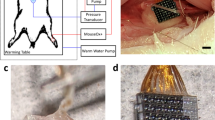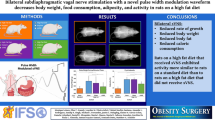Abstract
Background
Vagal nerve stimulation (VNS) has recently been indicated as a novel method for treating obesity. However, the optimal stimulation parameters were unknown and mechanisms were poorly understood. The aim of this study was to investigate the effects of VNS on food intake and body weight in diet-induced obesity (DIO) rats and its possible mechanism involving autonomic functions and gut hormones.
Methods
Ten control rats and 16 DIO rats were chronically implanted with one pair of electrodes in the subdiaphragmatic vagal nerve. VNS with different stimulation parameters and sham-VNS were performed in control rats. In a chronic study, 8 DIO rats were applied with VNS and another 8 DIO rats were treated with sham-VNS for 4 weeks. Food intake, body weight, gastric emptying, heart rate variability (HRV), and gut hormones were evaluated.
Results
In DIO rats, the food intake (p < 0.001) and body weight (p < 0.001) were significantly decreased in the VNS group, compared with the sham-VNS group. VNS decreased the sympathovagal ratio (p = 0.003) and increased vagal activity (p = 0.032) assessed from the spectral analysis of HRV. It also increased plasma levels of glucagon-like peptide-1 (p = 0.012), polypeptide YY (p = 0.008), and pancreatic polypeptide (p = 0.008) in DIO rats. Physiologically, VNS delayed solid gastric emptying (p < 0.001) and increased gastric volume (p = 0.004).
Conclusion
VNS with appropriate parameters reduced food intake and body weight by delaying gastric emptying mediated via the enhancement of vagal activity and release of anorexigenic hormones.







Similar content being viewed by others
References
WHO. Obesity and overweight. Fact sheet N311. Geneva: World Health Organization; 2015.
NCD Risk Factor Collaboration (NCD-RisC). Trends in adult body-mass index in 200 countries from 1975 to 2014: a pooled analysis of 1698 population-based measurement studies with 19.2 million participants. Lancet. 2016;387:1377–96.
Payab M, Hasani-Ranjbar S, Aletaha A, et al. Efficacy, safety, and mechanisms of herbal medicines used in the treatment of obesity: a protocol for systematic review. Medicine. 2018;97(1):e8825. https://doi.org/10.1097/MD.0000000000008825.
Buchwald H, Oien DM. Metabolic/bariatric surgery worldwide 2011. Obes Surg. 2013;23:427–36. https://doi.org/10.1007/s11695-012-0864-0.
Acosta A, Abu Dayyeh BK, Port JD, et al. Recent advances in clinical practice challenges and opportunities in the management of obesity. Gut. 2014;63:687–95. https://doi.org/10.1136/gutjnl-2013-306235.
Stefan H, Kreiselmeyer G, Kerling F, et al. Transcutaneous vagus nerve stimulation (t-VNS) in pharmacoresistant epilepsies: a proof of concept trial. Epilepsia. 2012;53:115–8. https://doi.org/10.1111/j.1528-1167.2012.03492.x.
Noe KH, Locke DEC, Sirven JI. Treatment of depression in patients with epilepsy. Curr Treat Options Neurol. 2011;13:371–9. https://doi.org/10.1007/s11940-011-0127-8.
De Ferrari GM, Crijns HJ, Borggrefe M, et al. Chronic vagus nerve stimulation: a new and promising therapeutic approach for chronic heart failure. Eur Heart J. 2011;32:845–77. https://doi.org/10.1093/eurheartj/ehq391.
Merrill CA, Jonsson M, Minthon L, et al. Vagus nerve stimulation in patients with Alzheimer’s disease: additional follow-up results of a pilot study through 1 year. The Journal of Clinical Psychiatry. 2006;67(8):1171–8.
Finocchi C, Villani V, Casucci G. Therapeutic strategies in migraine patients with mood and anxiety disorders: clinical evidence. Neurol Sci. 2010;31:95–8. https://doi.org/10.1007/s10072-010-0297-2.
Engineer ND, Riley JR, Seale JD, et al. Reversing pathological neural activity using targeted plasticity. Nature. 2011;470:101–4. https://doi.org/10.1038/nature09656.
Bodenlos JS, Kose S, Borckardt JJ, et al. Vagus nerve stimulation acutely alters food craving in adults with depression. Appetite. 2007;48:145–53. https://doi.org/10.1016/j.appet.2006.07.080.
Bodenlos JS, Kose S, Borckardt JJ, et al. Vagus nerve stimulation and emotional responses to food among depressed patients. J Diabetes Sci Technol. 2007;1:771–9. https://doi.org/10.1177/193229680700100524.
Burneo JG, Faught E, Knowlton R, et al. Weight loss associated with vagus nerve stimulation. Neurology. 2002;59:463–4. https://doi.org/10.1212/wnl.59.3.463.
Pardo JV, Sheikh SA, Kuskowski MA, et al. Weight loss during chronic, cervical vagus nerve stimulation in depressed patients with obesity: an observation. Int J Obes. 2007;31:1756–9. https://doi.org/10.1038/sj.ijo.0803666.
Park MI, Camilleri M. Gastric motor and sensory functions in obesity. Obes Res. 2005;13:491–500. https://doi.org/10.1038/oby.2005.51.
Bewick GA. Bowels control brain: gut hormones and obesity. Biochem Med (Zagreb). 2012;22:283–97.
Dai F, Lei Y, Li S, et al. Desvenlafaxine succinate ameliorates visceral hypersensitivity but delays solid gastric emptying in rats. Am J Physiol Gastrointest Liver Physiol. 2013;305:333–9. https://doi.org/10.1152/ajpgi.00224.2012.
Lu CL, Zou X, Orr WC, et al. Postprandial changes of sympathovagal balance measured by heart rate variability. Dig Dis Sci. 1999;44:857–61.
Kruger C, Kalenka A, Haunstetter A, et al. Baroreflex sensitivity and heart rate variability in conscious rats with myocardial infarction. Am J Phys. 1997;273:2240–7. https://doi.org/10.1152/ajpheart.1997.273.5.H2240.
Masi EB, Valdés-Ferrer SI, Steinberg BE. The vagus neurometabolic interface and clinical disease. Int J Obes. 2018;42:1101–11. https://doi.org/10.1038/s41366-018-0086-1.
de Lartigue G. Role of the vagus nerve in the development and treatment of diet-induced obesity. J Physiol. 2016;594:5791–815. https://doi.org/10.1113/JP271538.
Covasa M, Ritter RC. Adaptation to high-fat diet reduces inhibition of gastric emptying by CCK and intestinal oleate. Am J Physiol Regul Integr Comp Physiol. 2000;278:166–70. https://doi.org/10.1152/ajpregu.2000.278.1.R166.
Bugajski AJ, Gil K, Ziomber A, et al. Effect of long-term vagal stimulation on food intake and body weight during diet induced obesity in rats. J Physiol Pharmacol. 2007;58:5–12.
Val-Laillet D, Biraben A, Randuineau G, et al. Chronic vagus nerve stimulation decreased weight gain, food consumption and sweet craving in adult obese minipigs. Appetite. 2010;55:245–52. https://doi.org/10.1016/j.appet.2010.06.008.
Liu J, Jin H, Foreman RD, et al. Chronic electrical stimulation at acupoints reduces body weight and improves blood glucose in obese rats via autonomic pathway. Obes Surg. 2015;25:1209–16. https://doi.org/10.1007/s11695-014-1521-6.
Wan X, Yin J, Foreman R, et al. An optimized IES method and its inhibitory effects and mechanisms on food intake and body weight in diet-induced obese rats: IES for obesity. Obes Surg. 2017;27:3215–22. https://doi.org/10.1007/s11695-017-2743-1.
Li S, Maude-Griffin R, Sun Y, et al. Food intake and body weight responses to intermittent vs. continuous gastric electrical stimulation in diet-induced obese rats. Obes Surg. 2013;23:71–9. https://doi.org/10.1007/s11695-012-0773-2.
Kro’lczyk G, Laskiewicz J, Sobocki J, et al. The effects of baclofen on the feeding behaviour and body weight of vagally stimulated rats. J Physiol Pharmacol. 2005;56:121–31.
Ikramuddin S, Blackstone RP, Brancatisano A, et al. Effect of reversible intermittent intra-abdominal vagal nerve blockade on morbid obesity: the ReCharge randomized clinical trial. JAMA. 2014;312:915–22. https://doi.org/10.1001/jama.2014.10540.
Gil K, Bugajski A, Thor P. Electrical vagus nerve stimulation decreases food consumption and weight gain in rats fed a high-fat diet. J Physiol Pharmacol. 2011;62:637–46.
Gil K, Bugajski A, Kurnik M, et al. Electrical chronic vagus nerve stimulation activates the hypothalamic-pituitary-adrenal axis in rats fed high-fat diet. Neuro Endocrinol Lett. 2013;34:314–21.
Krolczyk G, Zurowski D, Sobocki J, et al. Effects of continuous microchip (MC) vagal neuromodulation on gastrointestinal function in rats. J Physiol Pharmacol. 2001;52:705–15.
Matyja A, Thor PJ, Sobocki J, et al. Effects of vagal pacing on food intake and body mass in pigs. Folia Med Cracov. 2004;45:55–62.
Osharina V, Bagaev V, Wallois F, et al. Autonomic response and Fos expression in the NTS following intermittent vagal stimulation: importance of pulse frequency. Auton Neurosci. 2006;126–127:72–80. https://doi.org/10.1016/j.autneu.2006.03.011.
Schwartz TW. Pancreatic polypeptide: a hormone under vagal control. Gastroenterology. 1983;85:1411–25.
Vijayvargiya P, Jameie-Oskooei S, Camilleri M,et al. Association between delayed gastric emptying and upper gastrointestinal symptoms: a systematic review and meta-analysis. Gut 2018;1–10. https://doi.org/10.1136/gutjnl-2018-316405.
Bray GA. Afferent signals regulating food intake. Proc Nutr Soc. 2000;59:373–84.
Monteiro MP, Batterham RL. The importance of the gastrointestinal tract in controlling food intake and regulating energy balance. Gastroenterology. 2017;152:1707–17. https://doi.org/10.1053/j.gastro.2017.01.053.
Holst JJ. The physiology of glucagon-like peptide 1. Physiol Rev. 2007;87:1409–39. https://doi.org/10.1152/physrev.00034.2006.
Herrmann C, Goke R, Richter G, et al. Glucagon-like peptide-1 and glucose-dependent insulin-releasing polypeptide plasma levels in response to nutrients. Digestion. 1995;56:117–26. https://doi.org/10.1159/000201231.
Johannessen H, Revesz D, Kodama Y, et al. Vagal blocking for obesity control: a possible mechanism-of-action. Obes Surg. 2017;27:177–85. https://doi.org/10.1007/s11695-016-2278-x.
Cummings DE, Weigle DS, Frayo RS, et al. Plasma ghrelin levels after diet-induced weight loss or gastric bypass surgery. N Engl J Med. 2002;346:1623–30. https://doi.org/10.1056/NEJMoa012908.
Author information
Authors and Affiliations
Contributions
Fei Dai: Conduct the experiment; data collection and drafting of the manuscript.
Jieyun Yin: Data analysis.
Jiande DZ Chen: Study design, critical revision of the manuscript.
Corresponding author
Ethics declarations
Conflict of Interest
The authors declare that they have no conflict of interest.
Ethical Approval
This research was approved by the Animal Care and Use Committee of the Veterans Affairs Medical Center (Oklahoma City, OK).
Informed Consent
Does not apply.
Additional information
Publisher’s Note
Springer Nature remains neutral with regard to jurisdictional claims in published maps and institutional affiliations.
Rights and permissions
About this article
Cite this article
Dai, F., Yin, J. & Chen, J.D.Z. Effects and Mechanisms of Vagal Nerve Stimulation on Body Weight in Diet-Induced Obese Rats. OBES SURG 30, 948–956 (2020). https://doi.org/10.1007/s11695-019-04365-7
Published:
Issue Date:
DOI: https://doi.org/10.1007/s11695-019-04365-7




